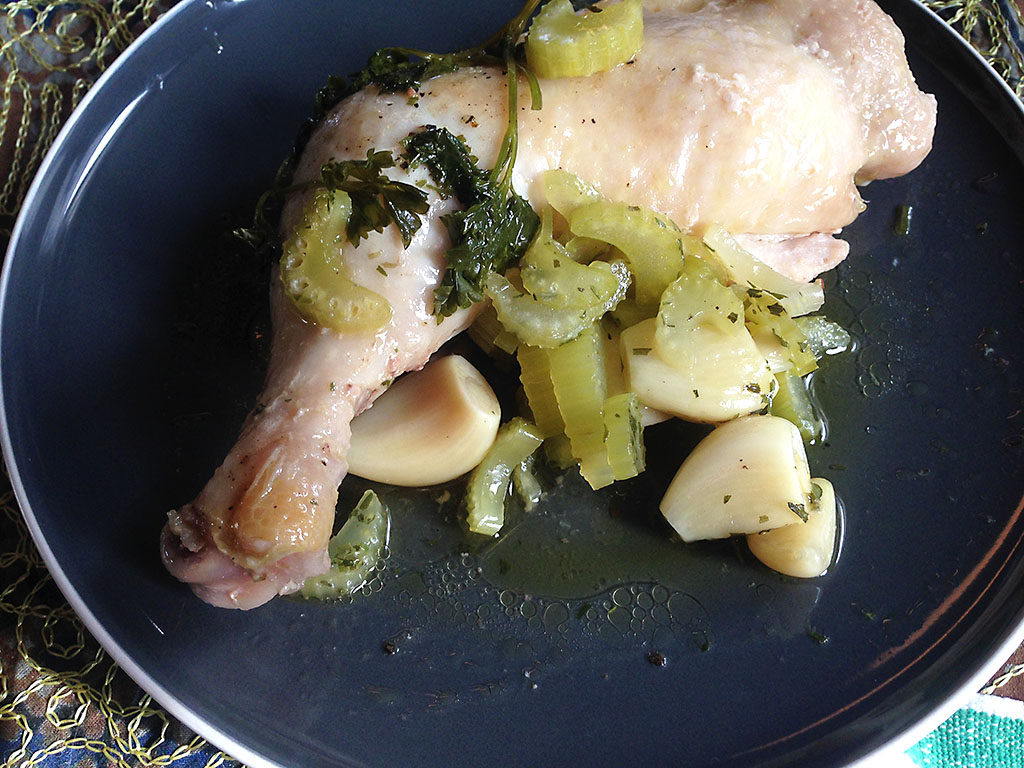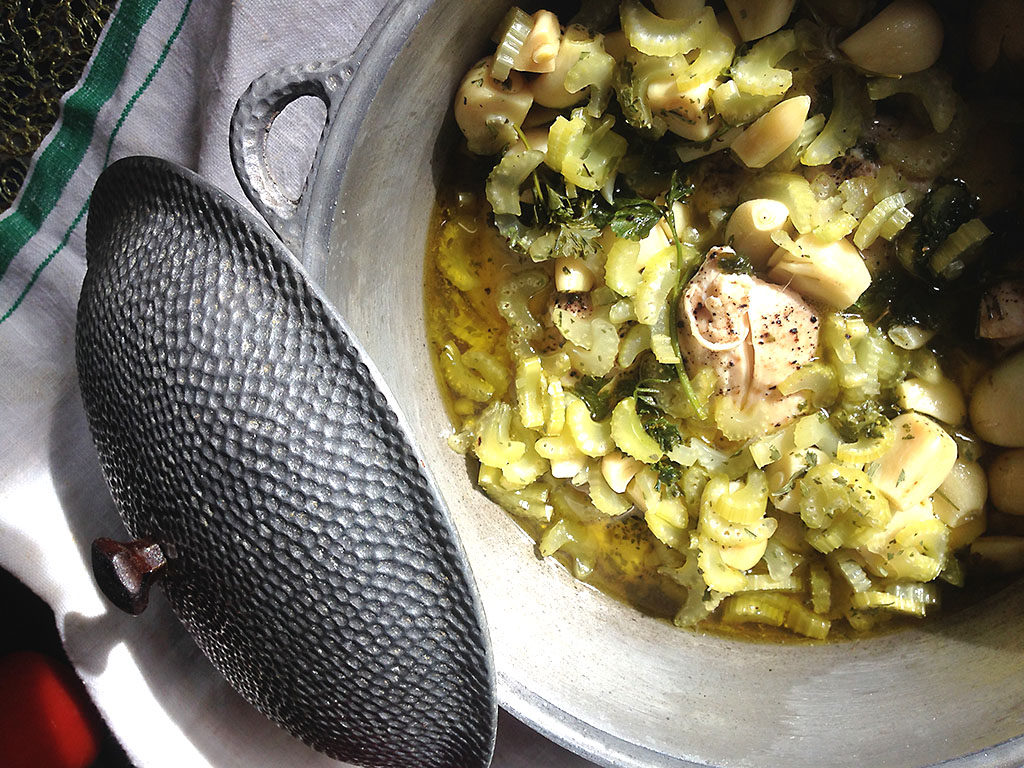 Chicken. With 40 cloves of garlic.
Chicken. With 40 cloves of garlic.
While writing my first book, Eight Flavors: The Untold Story of American Cuisine, I researched the eight most popular flavors in American cooking: black pepper, vanilla, chili powder, curry powder, soy sauce, garlic, MSG, and Sriracha. When I dived deep into each of these eight topics, I often found fascinating new information and recipes–some of which didn’t make it into the book. So over the next few months, I’ll be publishing this exclusive content on my blog! If it whets your appetite to read the whole book, make sure to get your own copy here.
I’m trying to get a handle on James Beard. In my generation, he wasn’t a household name; but once your reach a certain level of foodie-ness, you’re indoctrinated. You’re taught he’s a deity of American food.
According to Provence, 1970, Beard was “six foot three, three hundred pounds, and bald.” He described himself in this PBS documentary as “large and scarcely beautiful,” hardly a candidate for international super success. He enjoyed a jaunty bow tie; or, an even jauntier unbuttoned dress shirt. He was gregarious, always bringing people together, always quick to help out a new food talent in which he saw potential–like Julia Child, early in her career. He also kept his phone number listed in the phone book, and fans could look him up and give him a ring–unimaginable of a celebrity today. He would often “end up talking at great length to some woman in Iowa about her macaroons.” His mantra was to use the best, seasonal ingredients in the simplest, most flavorful preparations, and he embraced the diversity of American cuisine

Beard starred in the first food television show in 1946, a 15 minute program on NBC called “I Love to Eat.” Sadly, no copies of the episodes exist. Both Beard and Child created an interest in food that met in the middle between the housewiferly-domestic guides and the men-only haute restaurants of an earlier generation. In their DIY wake, cooks without formal culinary training began to open restaurants and head kitchens.
I was looking into Beard’s history during my writing process for Eight Flavors because he is often credited with convincing Americans to like garlic. Beard often looked to French cuisine for inspiration, and loved the simple, flavorful cuisine of Provence, which he first encountered while being stationed there during WWII. Provencal cuisine is also very garlic heavy. In America, leading up to WWII, people weren’t eating much garlic. It was associated with Italian immigrants, who were thought so unappealing, the US effectively banned Italian immigration in 1924. It was Beard who, with a rustic recipe, really began to change American’s minds about garlic.
“Chicken with Forty Cloves of Garlic” was first published in 1974. The recipe title sounds ridiculous and intimidating, but 40 cloves is only 2-3 heads of garlic. Beard calmly instructed his readers to fill a casserole with chicken legs and thighs, cover them with olive oil and vermouth, and top them with tarragon, parsley, celery and garlic–so much garlic, it serves the purpose of the vegetable in the dish. After baking for 90 minutes, the chicken comes out tender and mild–as does the garlic. Beard comforted the fears of worried cooks, stressed about the pungent taste of garlic: “Invite your guests to spread the softened garlic on the bread. They will find that the strong flavor has disappeared, leaving a wonderful, buttery paste perfumed with garlic.” It was the perfect recipe to convert the American masses because of the tame garlic flavor.
Beard championed a new form of American cooking; inspired by French cuisine, but not slavishly imitating it. He emphasized fresh, seasonal ingredients featured in ambitious, sophisticated dishes. “Buy the best produce you can buy and do the least to it, and you’ll have the best food,” Beard once said. And we have him to thank (in part) for garlic becoming a part of mainstream American cuisine.
Chicken with Forty Cloves of Garlic
Recipe from the James Beard Foundation
- 8 to 10 chicken legs
- 2/3 cup olive oil
- 2 teaspoons salt
- 1/4 teaspoon pepper
- Dash of nutmeg
- 40 cloves garlic, approximately 3 bulbs, peeled
- 4 stalks celery, sliced thinly
- 6 sprigs parsley
- 1 tablespoon dried tarragon
- 1/4 cup dry vermouth
Rinse chicken legs in cold water and pat dry with paper towels. Dip the chicken in olive oil to coat each piece and sprinkle with salt, pepper, and nutmeg.
Put chicken in a lidded 3-quart casserole along with the residue of oil. Add the garlic, sliced celery, parsley, tarragon, and vermouth. Seal the top of the casserole with a sheet of foil and cover tightly. Bake for 1 1/2 hours in a preheated 375ºF oven. Do not remove the lid during the baking period. Serve with hot toast or thin slices of pumpernickel and spread the softened garlic on the bread.


i made a version of this last week. My garlic turned to paste. As I really think yours will when you cook it 1 1/2 hours in a preheated 375ºF oven. Also your celery will breakdown. You food stylist makes pretty if not accurate photos.
Hi Barney. You’re wrong. I have no food stylist; it’s just me over here. I took this photo as I was recipe testing for my book, and it is in fact the very same Chicken and Garlic I cooked from that recipe.
Sounds like you did something wrong with your recipe. Or perhaps it was the variety or age of your garlic?
Thanks for complimenting my pretty photos, though. I try to make the best of what I have to work with.
Are you sure you left peels (outer “shells”) on each garlic clove?
Cloves should NOT be peeled. Then, when cooked, the interior of each clove should indeed be a kind of paste that is easily spread on bread. You squeeze
each clove and out pops the luxurious garlic paste.
This is a classic, time-tested recipe; one of the all-time greats.
Good luck if you try again.
Oh my God, I’ve made this recipe for years and years. I never knew that I didn’t have to peel the garlic!
I definitely peeled the garlic! It’s not like roasted garlic, it’s reallt slow cooked and smushy. You don’t want to be scooping out garlic papers. The original recipe definitely tells you do peel the cloves; I wouldn’t recommend leaving the peels on
“The original recipe definitely tells you **do peel the cloves**…”
No. NO, it does NOT. Beard’s original discussion includes the directions NOT to peel the last layer of papery sheath from each clove and to squeeze one end of each garlic clove’s sheath to force the steam-softened garlic onto the bread/toast.
Why bother to manufacture a demonstrably untrue remark? Yikes!
Barney,
Your experience and analysis strike me as entirely correct, BUT this is NOT Beard’s recipe instruction-wise.
Beard placed the celery and onion entirely in the bottom of the cooking vessel. Those ingredients were not intended to be eaten – they were a semi-mirepoix, intended to hold the bottom-most pieces of chicken above the liquids. The idea was to steam the chicken and garlic in the liquids of aromatics and dry white wine. The cooking time and temp give a very long reflux cycle that ensure a thorough infiltration of all flavors.
The proper placement of the ingredients is:
1) celery and onion in the bottom;
2) chicken (I use drumsticks only) next;
3) garlic cloves in their papery sheaths need to be artfully tucked into the nooks and crannies created by the stacking of the chicken – also NOT allowed to touch the bottom of the cooking vessel – like the chicken, we want the garlic to steam.
Buy the book, “The New James Beard Cookbook” for the master’s original, accurate take on this recipe.
Richard
I’ve made this recipe dozens of times – never pasty, never broken down celery….always amazing.
Have a question, though:
Am considering making this with skinless chicken pieces…..use more olive oil? Don’t want the chicken to be dry, but the dish is always very oily by the end, even more so from the chicken skin..
Thanks!